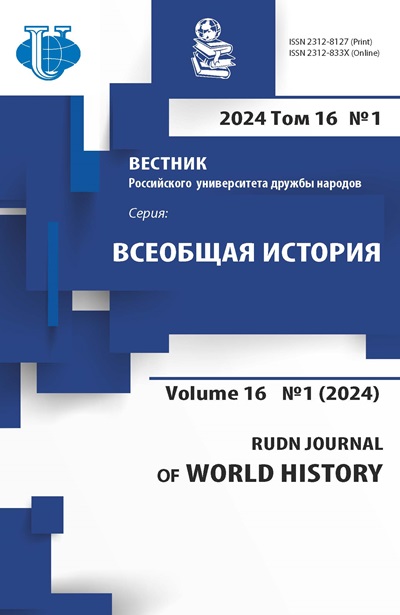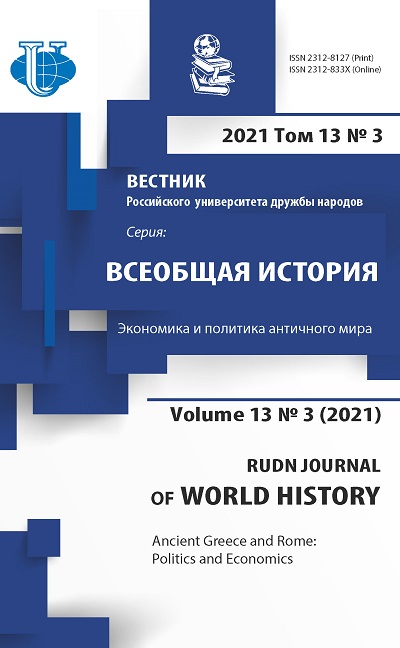Veteran’s estate as a category of roman land surveying
- Authors: Gvozdeva I.A.1
-
Affiliations:
- Lomonosov Moscow State University
- Issue: Vol 13, No 3 (2021): Ancient Greece and Rome: Politics and Economics
- Pages: 299-309
- Section: AGRARIAN STRUCTURE AND ECONOMIC LIFE OF ANCIENT ROME
- URL: https://journals.rudn.ru/world-history/article/view/27324
- DOI: https://doi.org/10.22363/2312-8127-2021-13-3-299-309
Cite item
Full Text
Abstract
The purpose of this paper is to investigate how did form veteran’s landowning in the Roman land surveying. The main sources on the problem are the treatises of Roman land surveyers (1-2 centuries AD). They contain information about the principles of surveying of land plots for Roman retirees and about right guarantees the veterans had. The task of this article is reconstruction of the process of civic assignations in Ancient Rome and highlighting of features of this action when land was granted to the veterans. At the end of 2nd century BC the limitatio has become the most common way of land division thank to activities of brothers Gracchi. The limitatio assumed the creation of dividers that organized space: Decumanus maximus and Cardo maximus . Their intersection created four parts of the future Ager Colonicus for veterans. The limits parallel to the main ones turned the colony field into a clearly organized boundary grid with a square unit of area - centuria, within which the land plots (intended for tillage, horticulture, viticulture) were formed for veterans. Since the time of Caesar and Augustus, the question of adding grazing land to the arable land was decided in the Roman land surveying art. The most desired types of non-arable land was not only forests, pastureland and relicta but also subseciva - remainders from land division. Those vacant centuriae were a good arable land which the state temporarily allocated to new settlers on a lease basis. In the cadastre, a special right of remainders (ius subsecivorum) was created, unifying the lease relations. Thus, the farm of the Roman veteran consisted of fertile land suitable for all types of agricultural activities, as well as different categories of land, which contributed to the development of property and ownership relations.
Keywords
About the authors
Inna Andreevna Gvozdeva
Lomonosov Moscow State University
Author for correspondence.
Email: innagvozdeva@mail.ru
PhD in Historical Sciences
27-4 Lomonosovsky Ave., Moscow, Russian Federation, 119991, GSP-1References
- Kuzishchin VI. Rimskoe rabovladel’cheskoe pomest’e II v. do n. je. – I v. n. je. [Roman slaveholding estate of the II century BC – I century AD]. M., 1973. (In Russ.).
- Kuzishchin VI. Genezis rabovladel’cheskih latifundij v Italii (II v. do n. je. – I v. n. je.) [Genesis of slave-owning latifundia in Italy (II century BC – I century AD)]. M., 1976. (In Russ.).
- Lintott A. Judicial Reform and Land Reform in the Roman Republic. Cambridge, 1992.
- Schulten A. Die Römische Flurteilung und ihre Reste. Berlin: Weidmann., 1898.
- Gvozdeva IA, Gvozdeva TB. Agri divisi v rimskoj agrimensure [Agri divisi in Roman agrimensura]. Agrarian and land law. 2020;9(189):95–98. (In Russ.).
- Castаgnoli F. Le ricerche sui resti della Centuriazione. Roma, 1958.
- Bradford J. Ancient landscape: Studies in field archeology. L.: Bell, 1957.
- Kuzishhin VI. Formirovanie prava chastnoj sobstvennosti v rimskoj jurisprudencii vo II–I vv. do n.je. [Formation of private property rights in Roman jurisprudence in the II–I centuries BC]. In: Kuzishchin VI. Studies in the economic history of antiquity. SPb., 2011, p. 187–199. (In Russ.).
- Kay Ph. Rome’s economic revolution. Oxford: Oxford univ. press, 2014.
- Gsell St. Histoire Ancienne de L’Afrique du Nord. Vol. VII. La République romaine et les rois indigènes. Paris, 1928.
- Salmon E.T. Roman colonisation under the republic. L., 1969.
- Caillemer A., Chevallier R. Atlas des centuriations romaines de Tunisie. Paris: I.G.N. 1954.
- Moatti C. Archives et partage de la terrе dans le monde romain. (IIe siècle avant – Ier siècle après J.–C.). Roma, 1993.
- Clavel-Lévêque M. Centuriation, géométrie et harmonie: le cas du Biterrois. In: Mathématiques dans l’antiquité, Centre Jean-Palerne: Mémoires 11. Guillaumin, J.-Y. (ed.). StÉtienne: Université de St-Étienne, 1992. P. 161–184.
- Hinrichs FT. Die Geschichte der gromatischen Institutionen. Wiesbaden, 1974.
- Maggiani A. Agricultura e disciplina etrusca. Il mondo rurale etrusco. Firenza, 2009. P. 139–156.
- Morris J. Shaping the Empire: Agrimensores, Emperors and the Creation of the Roman Provincial Identities. Vol. I. Leicester, 2016.
- Guillaumin J.-Y., Clavel-Lévêque M. Drainage et géométrie dans la centuriation de Cesena. Dialogues d’histoire ancienne. 2000;26(1):204–208.
- Orejas A., Sastre Prat I., Clavel-Lévêque M. Auguste et la première organisation du Nord-Ouest de la Péninsule Ibérique: L’Édit du Bierzo (Léon, Espagne). Dialogues d’histoire ancienne. 2000;26(1):200–204.
- Mommsen Th. Römischen Staarsrecht. Bd. 1–3. Leipzig: Hirsel, 1887–1888. Bd. 3. Abt. 1. 1887.
- Burdese L. Studi sull’ager publicus. Torino: Giappichelli, 1952.
- Grelle F. L’appatenenza del suelo provinciale nell’analisi di gaio 2.7. e 2.21. Index. Napoli, 1980;(18):168.
- Gvozdeva IA. Ager arcifinius i nachalo rimskogo zemel’nogo prava [Ager arcifinius and the beginning of Roman land law]. The ancient East and the ancient world. 2018;(8):340–355. (In Russ.).













